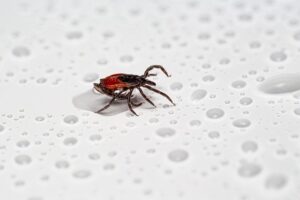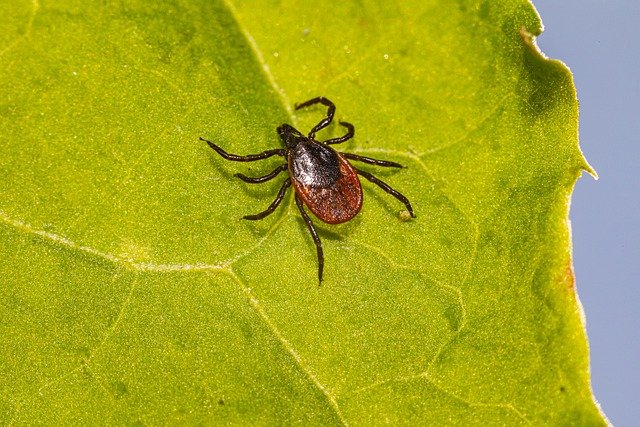
A bulls-eye rash, also called erythema migrans, is one of the telltale signs of Lyme disease.
Lyme disease is characterized by fever, headaches, tiredness, and a distinctive bulls-eye skin rash known as erythema migrans.
‘How can I be sure that I don’t have Lyme disease?’ is one of the most frequently asked questions by patients visiting their primary care provider.
What is Lyme disease?
Lyme disease is a bacterial infection that can be transmitted to humans through the bite of an infected black legged tick (Ixodes scapularis) also called deer tick.
If detected and treated early, Lyme disease usually can be fully cured.
It is important to remember that not all ticks are infected with Borrelia burgdorferi, the bacterium that causes Lyme disease.
What causes Lyme disease?
Several factors may increase a person’s risk of getting Lyme disease, including:
- Walking in wooded, grassy, brush-filled areas with abundant ticks
- Spending time in tick-infested areas
- Working or playing outdoors where ticks are prevalent
What are the symptoms of Lyme disease?
A bulls-eye rash, also called erythema migrans, is one of the telltale signs of Lyme disease. It usually appears at the site of a tick bite between 3 and 30 days after being bitten by an infected tick.
The rash may be warm but is not usually painful. Many people with early Lyme disease recall the appearance of a large bulls-eye rash. If the rash is not treated, it may spread to other parts of your body.
Rashes associated with Lyme disease may resemble other skin conditions.
What happens if Lyme disease is not treated?

If Lyme disease is left untreated, it can produce different symptoms in about 20% of the untreated infections in humans in the form of erythema migrans (skin rash), neurological deficits, cardiac problems and musculoskeletal problems.
Even though it is rare, Lyme disease can cause death.
In Europe and Asia, the infection has been known for centuries as ‘The great imitator’ because of its diverse manifestations. In North America, a similar burden of disease was first reported in 1975 from a region on the coast of the Long Island, New York.
Lyme disease is now the most common vector-borne disease in North America.
Studies suggest that climate has contributed to its rapid spread since being introduced in Pennsylvania in 1983. It is also documented in Europe, Asia, and Australia.
How can I be sure that I don’t have Lyme disease?
If you are not in an area where there are reported cases of Lyme disease, the only way to know for sure is not to get tested.
If you live or spend time in an area where Lyme disease is endemic and you have the symptoms associated with the infection, it would be appropriate to visit your primary care provider for testing.
Lyme disease is commonly misdiagnosed because its symptoms are similar to diseases such as multiple sclerosis, rheumatoid arthritis, chronic fatigue syndrome and fibromyalgia.
Lyme disease can be diagnosed by identifying the Borrelia burgdorferi bacterium in a blood sample or through the detection of antibodies in your blood.
The two major types of tests that are used to diagnose Lyme disease are the enzyme-linked immunosorbent assay (ELISA) test and the Western blot.
- Related post: What happens if you don’t treat a fractured rib
- Related post: What Would Happen If You Didn’t Get Your Sleep
What is the treatment for Lyme disease?
The recommended treatment for early localized or early disseminated Lyme disease is 10 to 21 days of an antibiotic that is effective against the bacterium B. burgdorferi which is usually doxycycline, amoxicillin or cefuroxime axetil.
If you live in an endemic area, consult your doctor about taking preventive antibiotics if you are bitten by a tick.
What can you do to protect yourself from Lyme disease?
If you live or spend time in an area where Lyme disease is endemic and wear light-colored clothing with long sleeves, pants tucked into socks and hats that cover the head try to avoid areas with high grass and leaf litter.
If you know you have been bitten by a tick, remove the attached tick promptly with fine-point tweezers.
Do not try to burn or smother an attached tick, or use petroleum jelly, alcohol, nail polish remover or other home remedies. This may cause the tick to regurgitate infected bodily fluids into the bite wound.
Wash your hands with soap and water after removing a tick, and avoid handling the tick. Some ticks secrete a cement-like substance that binds them to their host.
Do not crush or squeeze ticks when you remove them from your skin. If you cannot easily grasp the tick’s mouthparts with tweezers, leave the tick in place and get medical help.
After removing the tick, clean your hands with rubbing alcohol or soap and water. If you have a mild reaction to being bitten by a tick, such as redness around the bite site that may become swollen or itchy, apply an antiseptic to the area three times a day.
If your bite is more severe, develops a red rash or flu-like symptoms occur, see your doctor immediately.



